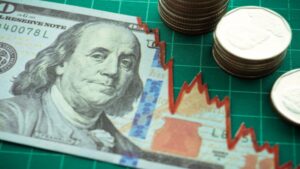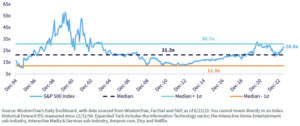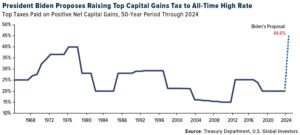History shapes our views, and we are always seeking analogues to current events. Even if we know past performance is not indicative of future performance we are still comforted when we draw parallels to the past. Many are now drawing parallels between the current tech enthusiasm and the dawn of the internet.
We also recently spoke with Professor Jeremy Siegel, who has written extensively on the historical performance of equities. He pointed out that what we are seeing in 2023 is not similar to what we saw in 2000 when the tech bubble burst, especially in terms of fundamentals and valuation. We wanted to explore this idea further with this piece.
The quintessential bubble developed in the late 1990s. Some hallmarks of that time:
- When companies put the suffix “.com” in their name, their share prices soared. Any company could do so, regardless of real business prospects or potential.
- In the absence of profits or even sales, new metrics were created to make the case for progress in business, like webpage visits or clicks.
- Many leading internet companies did not have positive earnings, but even in the more established S&P 500, which requires profitability for inclusion, price levels approached 100x earnings for many large-cap names. Hundreds of billions of dollars of market capitalization was supported by dreams of wild future profits.
And what has been happening in the first half of 2023:
- There are some companies putting “AI” in their names, but it is not yet a huge number and they have real business reasons for doing so. Additionally, at least so far, not many private companies have tapped the public markets.
- Naturally, investors will look to track measures like the intensity with which firms are using AI or engaging with data. Because people remember the tech bubble period, we doubt that people will again say that ‘earnings don’t matter’ or ‘revenues don’t matter’—or at least that could still be some time away.
- When we look at how the big indexes, like the Nasdaq 100 Index and the S&P 500 Index, are being driven higher by the largest companies, we see that all those large companies are ‘real businesses.’ They have revenues, cash flows and earnings. It’s absolutely true that investors might look at Nvidia, as an example, and think its multiple is too high for the growth they expect to see—but it’s not a case of Nvidia selling the dream of making a chip one day. Nvidia chips exist, they are sold, and Nvidia is the clear leader in providing the graphics processing units (GPUs) that allow AI to run.
Our conclusion—even if the market could very well be ripe for a near-term correction after a nearly six-month run, and even if that run has been accompanied by a hype cycle in AI, we are not seeing signals that broad technology focused stocks are in bubble territory.
Let’s Look at Some Numbers…
During the tech bubble investors decided to not look at the classic statistics. We will not make that mistake here. Looking at figure 1:
- We create a view of an ‘Expanded Tech’ sector. Companies like Meta Platforms and Alphabet are in the Communication Services sector. Amazon.com (even accounting for that .com suffix) is in Consumer Discretionary. Information Technology includes Microsoft and Apple. If we use this Expanded Tech designation, we capture a broader cross section of technology.
- In 1998–2000, roughly speaking, the S&P 500 was hitting a forward P/E ratio of more than 55x. The initial run up was based on prices and euphoria—the second spike into the 50x range would have been from the quick drop in forward earnings expectations when the popping of the bubble was clear.
- If we then ask—what is this same index trading at in terms of forward P/E at present—it is still below 30x. As 28.4x is not ‘cheap,’ we are not seeking to indicate tech is currently cheap in any way.
- Back in 2000, real interest rates were higher. However, we note that this multiple expansion has occurred alongside a higher interest rate environment—not always an easy feat for stocks to achieve. In 2000 when the tech sector was over 55x forward earnings, real interest rates (measured by TIPS bonds) were double where they are currently.
Figure 1: S&P 500 Expanded Tech Forward P/E Ratio over Time

Then, in figure 2:
- We can see how the ‘other stocks’ that are not tech have been doing by way of valuation. These other stocks never broke a 30x forward P/E ratio during the tech bubble.
- The current valuation of the expanded tech part of S&P 500 is at 16.7x and is very close to the average over the full period. This is not cheap, but nor is it getting into the more expensive territory.
Figure 2: S&P 500 Expanded Tech Forward P/E Ratio over Time


Our bottom line: A bubble is not just ‘a bit expensive’ or ‘kinda expensive,’ but rather represents a situation where prices have clearly gone far beyond fundamentals. Forcing ourselves back to a classic figure, forward P/E ratio, we don’t see evidence of that being the case.
Dealing with the AI Hype Cycle
Still, we recognize that performance in thematic equities can come in waves. One way to deal with these waves is to allocate to certain themes and then recognize that over a cycle—something closer to 10 years than 5—there are going to be periods of strongly positive and strongly negative returns.
In many cases, knowing whether the themes are working or not is something completely different from looking at the share price performance. What we know today is that, in the current quarter, Nvidia is expecting revenues in the range of $11 billion. It will be critical to watch that trajectory, which then indicates a 12-month run rate above $40 billion. Do we actually see that materialize? Similarly, companies like Microsoft and Alphabet will continue to talk about the topic and launch new options for their customers. These are the kinds of things that we can honestly see and monitor.
Signals of a greater degree of froth could entail seeing a much more robust IPO market in specific AI companies, which may happen in the future but is not yet here. We are not saying that one day there cannot ultimately be a bubble—we are all still human, and human behaviors create bubbles—but what we are not yet seeing one.
For those interested in hearing more about AI and the potential bubble, we recently hosted a webinar with Professor Jeremy Siegel and myself, which dives further into this topic: AI and the Markets.
—
Originally Posted June 29, 2023 – Is AI Excitement Creating a Stock Market Bubble?
Disclosure: WisdomTree U.S.
Investors should carefully consider the investment objectives, risks, charges and expenses of the Funds before investing. U.S. investors only: To obtain a prospectus containing this and other important information, please call 866.909.WISE (9473) or click here to view or download a prospectus online. Read the prospectus carefully before you invest. There are risks involved with investing, including the possible loss of principal. Past performance does not guarantee future results.
You cannot invest directly in an index.
Foreign investing involves currency, political and economic risk. Funds focusing on a single country, sector and/or funds that emphasize investments in smaller companies may experience greater price volatility. Investments in emerging markets, real estate, currency, fixed income and alternative investments include additional risks. Due to the investment strategy of certain Funds, they may make higher capital gain distributions than other ETFs. Please see prospectus for discussion of risks.
WisdomTree Funds are distributed by Foreside Fund Services, LLC, in the U.S. only.
Interactive Advisors offers two portfolios powered by WisdomTree: the WisdomTree Aggressive and WisdomTree Moderately Aggressive with Alts portfolios.
Disclosure: Interactive Brokers
Information posted on IBKR Campus that is provided by third-parties does NOT constitute a recommendation that you should contract for the services of that third party. Third-party participants who contribute to IBKR Campus are independent of Interactive Brokers and Interactive Brokers does not make any representations or warranties concerning the services offered, their past or future performance, or the accuracy of the information provided by the third party. Past performance is no guarantee of future results.
This material is from WisdomTree U.S. and is being posted with its permission. The views expressed in this material are solely those of the author and/or WisdomTree U.S. and Interactive Brokers is not endorsing or recommending any investment or trading discussed in the material. This material is not and should not be construed as an offer to buy or sell any security. It should not be construed as research or investment advice or a recommendation to buy, sell or hold any security or commodity. This material does not and is not intended to take into account the particular financial conditions, investment objectives or requirements of individual customers. Before acting on this material, you should consider whether it is suitable for your particular circumstances and, as necessary, seek professional advice.


































Join The Conversation
If you have a general question, it may already be covered in our FAQs. If you have an account-specific question or concern, please reach out to Client Services.